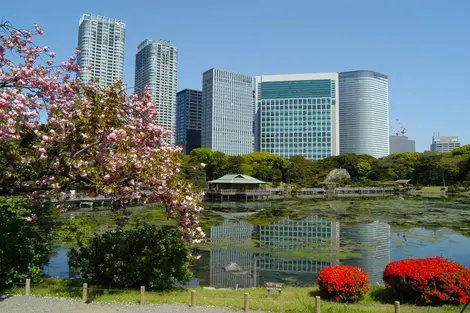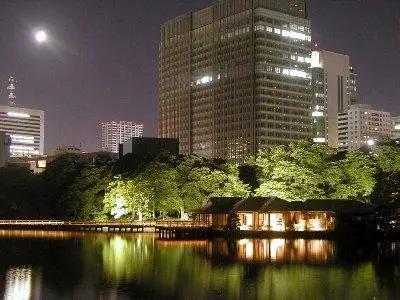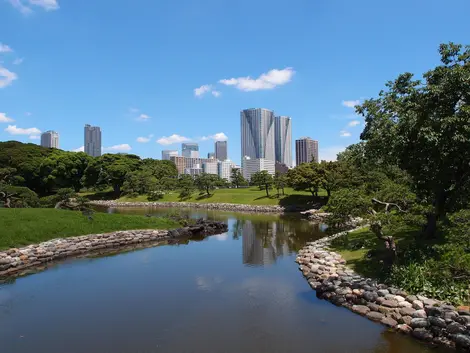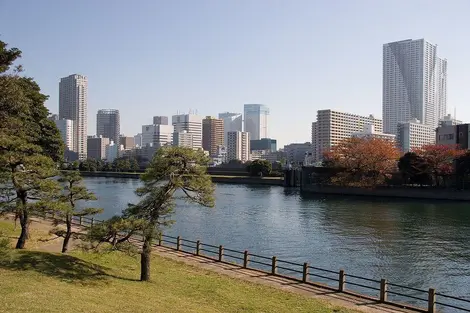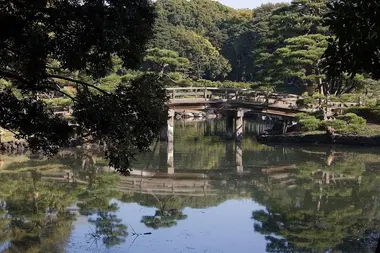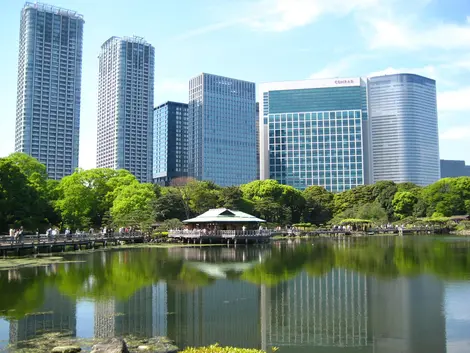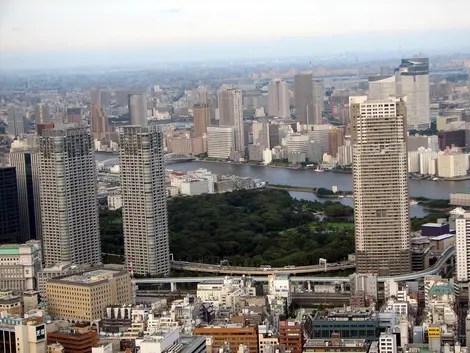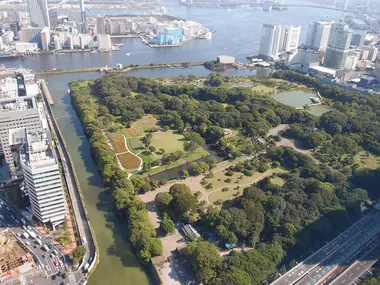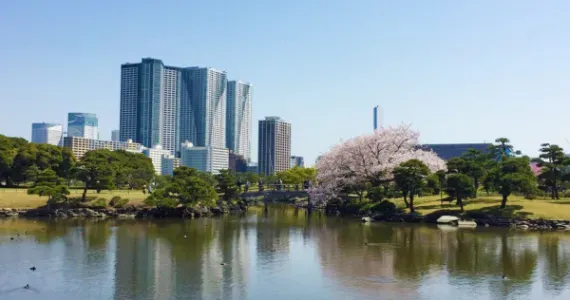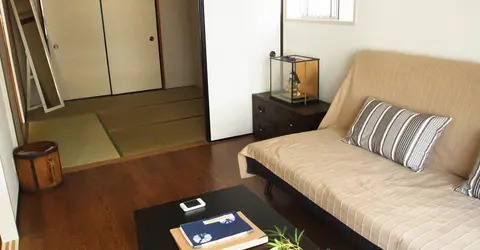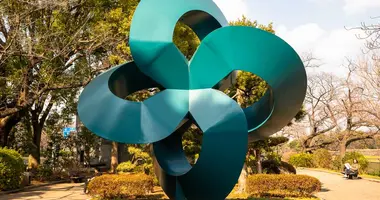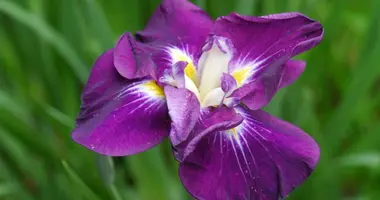The Hama-Rikyu Onshi Teien garden 浜離宮恩賜庭園
- Published on : 17/07/2019
- by : E.P. / O.F.
- Youtube
One of the most beautiful traditional Japanese gardens to visit in Tokyo
Meeting the Sumida River and Tokyo Bay and a stone's throw from the old Tsukiji fish market, the Hama-Rikyu Onshi Teien is an iconic garden of the Japanese capital. It seduces with its ponds and tea pavilions which offer a breath of fresh air and serenity in the heart of downtown Tokyo.
A vestige of the Edo and Tokugawa period
The bustle of restaurants around the old Tsukiji fish market gives way to the calm of the former hunting reserve of the Tokugawa clan shoguns; their garden, the Hama-Rikyu Onshi Teien, remains one of the most beautiful in Tokyo. It is a particularly protected place since it has been a "special historical site" in Japan since 1952.
The garden has had different roles over the centuries. Originally built as a feudal lord's residence in Tokyo and for duck hunting during the Edo period (1603-1867), it later served as a promenade garden and secondary imperial palace. Property of the Emperor during the Meiji era (1868-1912), was bequeathed to the municipality of Tokyo in 1945 by Emperor Hirohito. The Hama-Rikyu Onshi Teien traces in its own way in the history of Japan and its succession of political and imperial eras. It was opened to the public in April 1946, to the delight of Tokyoites and visitors to the capital.
Despite the great Kanto earthquake of 1923 and the bombings of World War II in 1945, which largely destroyed the garden, the main elements, such as the tea houses and the three ponds, have been preserved or rebuilt.
Remnants of these ancient roles are also still visible today throughout the garden. In particular, several small duck hunting huts were reconstructed identically as well as the remains of an old ditch and a stone wall.
- Read also: Visit Tokyo in the footsteps of the Tokugawa
A traditional Japanese garden in the heart of Tokyo
The Hama-Rikyu Garden is a fine example of gardens from the Edo period (1603-1867) and is one of the few in the region to survive to the present day.
Miniaturized and stylized, this plant world illustrates the definition of Japanese gardens: borrowing from a natural landscape.
The traditional-style garden contrasts with the skyscrapers of the surrounding Shiodome district and is the perfect representation of the blend of tradition and modernity that characterizes Japan in the eyes of the world.
The different bodies of water in the garden illustrate the splendor of controlled geometric accuracy. Cross the Shioiri pond by a small pontoon and reach the islet where the most famous tea house in the garden sits, awarding you, with a cup of green tea and sweets, to taste Japan.
And the garden is also home to a bird reserve, a little corner of paradise!
Not to be missed: Hamarikyu Garden
- Shioiri-no-ike
Located at the mouth of Tokyo Bay, the garden also has a seawater basin that changes level with the tides. Shioiri-no-ike is the only seawater pond remaining in Tokyo. As the tide rises and falls, an airlock opens and closes to regulate the water level.
There are many types of saltwater fish in the pond, including mullet, bass, gobies, and eels. This peculiarity makes the garden even more special and connected to the nature that surrounds it.
- Sanhyakunen-no-matsu
As the 6th Shogun, Ienobu Tokugawa (1662 - 1712), renovated the garden, a large pine tree was planted to celebrate the event. This majestic 300-year-old tree has survived to the present day despite the bombardments and destruction in the 20th century.
- Nakajima-no-ochaya
This pavilion serving as a tea room was built in 1704 on the Nakajima islet in Shiori-no-ike pond. It was then used by the Tokugawa shoguns and the nobles of the imperial court who came to relax near Tokyo Bay. The tea room was identically renovated in 1983 and now you too can enjoy tea accompanied by traditional Japanese sweets.
Two other tea pavilions, Matsu-no-ochaya and Tsubame-no-ochaya, destroyed during the war, have also recently been rebuilt.
- O-tsutai-bashi
This large 118-meter-long wooden bridge connects two islets of the garden ponds: Kono-ji shima and Nakajima. The entire bridge is made from "hinoki", a Japanese cypress tree, and was completed in May 1997.
How to get to the Hama-rikyu garden?
Access to Hama-rikyu is possible by metro or by water with the Tokyo Water Bus.
Access to Hama-rikyu by subway: the garden is a 10/15 min walk fromShimbashi station or a 5/10 min walk from Shiodome station, with the Oedo and Yurikamome subway lines.
Access to Hama-rikyu by the Tokyo Water Bus: you can also access the garden from the Asakusa district with the Sumidagawa river line departing from Asakusa every 30 min. The fare on the Tokyo Water Bus is 1,040 yen, or about $9/8€ (370 yen for a child), and the trip takes 35 min. The entrance fee to the garden is included in this price.
Visitez les jardins de Tokyo avec un guide !
Address, timetable & access
Address
Phone
03-3541-0200Timetable
Oedo line Tsukijishijo stop, exit A2 or Shiodome, exit 10Price
Adults: 300 yen (around $2.50/2€) seniors 65 years and over: 150 yen ($1.25/1€) Free for kindergarten and primary school children.Access
Open every day from 9 am to 5 pm (admission until 4:30 pm) Closed from December 29 to January 1




